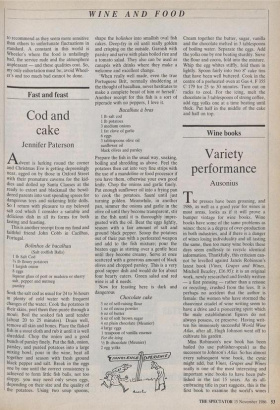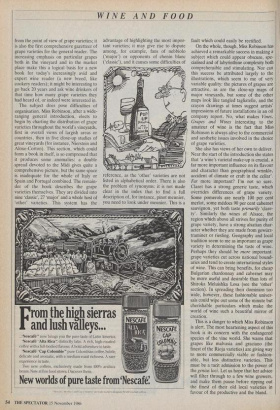Wine books
Variety performance
Ausonius
The presses have been groaning, and 1986, as well as a good year for wines in most areas, looks as if it will prove a bumper vintage for wine books. Wine books have some of the same problems as wines: there is a degree of over-production in both industries, and if there is a danger of wines losing individuality and all tasting the same, then too many wine books these days seem endlessly to recycle identical information. Thankfully, this criticism can- not be levelled against Jancis Robinson's latest book (Vines, Grapes and Wines, Mitchell Beazley, £16.95): it is an original work, newly researched and freshly written — a first pressing — rather than a reissue or recycling, crushed from the lees. It is perhaps no accident that the author is female: the women who have stormed the chauvinist citadel of wine writing seem to have a drive and a pioneering spirit which the male establishment figures do not always possess, or preserve. Having writ- ten his immensely successful World Wine Atlas, after ail, Hugh Johnson went off to cultivate his garden.
Miss Robinson's new book has been hailed (to use publisher-speak) as the successor to Johnson's Atlas. So has almost every subsequent wine book, the cynic might add, but Vines, Grapes and Wines really is one of the most interesting and important wine books to have been pub- lished in the last 15 years. As its all- embracing title in part suggests, this is the first book to examine the world's wines
WINE AND FOOD
from the point of view of grape varieties; it is also the first comprehensive gazetteer of grape varieties for the general reader. The increasing emphasis on particular grapes both in the vineyard and in the market place make this a logical basis for a new book for today's increasingly avid and expert wine reader (a new breed, like cookery readers); it might be interesting to go back 20 years and ask wine drinkers of that time how many grape varieties they had heard of, or indeed were interested in.
The subject does pose difficulties of organisation. Miss Robinson, after a wide- ranging general introduction, elects to begin by charting the distribution of grape varieties throughout the world's vineyards, first in overall views of largish areas or countries, then in five close-up studies of great vineyards (for instance, Nierstein and Aloxe-Corton). This section, which could form a book in itself, is so compressed that it produces some anomalies: a double spread devoted to the Midi gives quite a comprehensive picture, but the same space is inadequate for the whole of Italy or Spain and Portugal combined. The remain- der of the book describes the grape varieties themselves. They are divided into nine 'classic', 27 'major' and a whole host of `other' varieties. This system has the advantage of highlighting the most impor- tant varieties; it may give rise to dispute among, for example, fans of nebbiolo (`major') or opponents of chenin blanc (`classic'), and it causes some difficulties of reference, as the 'other' varieties are not listed in alphabetical order. There is also the problem of synonyms: it is not made clear in the index that to find a full description of, for instance, pinot meunier, you need to look under meunier. This is a fault which could easily be rectified.
On the whole, though, Miss Robinson has achieved a remarkable success in making a subject which could appear obscure, spe- cialised and of labyrinthine complexity both comprehensible and stimulating. Nor can this success be attributed largely to the illustrations, which seem to me of very variable quality: the pictures of grapes are attractive, as are the close-up maps of major vineyards, but some of the other maps look like tangled tagliatelle, and the crayon drawings at times suggest artists' impressions of future installations in an oil company report. No, what makes Vines, Grapes and Wines interesting to the amateur of wine is the fact that Miss Robinson is always alive to the commercial and aesthetic issues involved in the choice of grape varieties.
She also has views of her own to deliver. Near the start of the introduction she states that 'a wine's varietal make-up is crucial, a far more important influence on its flavour and character than geographical wrinkle, accident of climate or craft in the .cellar'. Far more important? I'm not so sure. Claret has a strong generic taste, which cherrides differences of grape variety. Some pomerols are nearly 100 per cent merlot, some m6docs 90 per cent cabernet sauvignon, yet both taste primarily 'dare- ty'. Similarly the wines of Alsace, the region which above all strives for purity of grape variety, have a strong alsatian char- acter whether they are made from gewfirz- traminer or riesling. Geography and local tradition seem to me as important as grape variety in determining the taste of wine. Perhaps they should be more important: grape varieties cut across national bound- aries and tend to create international styles of wine. This can bring benefits, for cheap Bulgarian chardonnay and cabernet may be more useful and desirable than lots of Shiroka Meluishka Losa (see the 'other' section). In spreading their dominion too wide, however, these fashionable univer- sals could wipe out some of the minute but cherishable particulars which make the world of wine such a beautiful mirror of creation.
This is a danger to which Miss Robinson is alert. The most heartening aspect of this book is its concern with the endangered species of the vine world. She warns that grapes like malvasia and graciano (the finest of the Rioja varieties) are giving way to more commercially viable or fashion- able, but less distinctive varieties. This must be a tacit admission to the power of the genius loci. Let us hope that her advice will filter through to a few wine growers, and make them pause before ripping out the finest of their old local varieties in favour of the productive and the bland.



































































 Previous page
Previous page